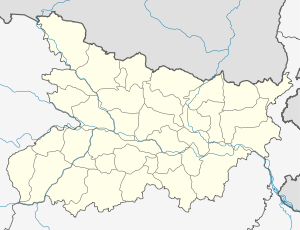Kesaria
| Kesariya केसरिया Kasariya | |
|---|---|
| Hamlet | |
| Nickname(s): Kesaputta | |
 Kesariya Location in Bihar, India  Kesariya Kesariya (Bihar) | |
| Coordinates: 26°20′03″N 84°51′17″E / 26.334192°N 84.854820°ECoordinates: 26°20′03″N 84°51′17″E / 26.334192°N 84.854820°E | |
| Country |
|
| State | Bihar |
| District | East Champaran |
| Government | |
| • Type | State Government |
| • Body | Bihar |
| Elevation | 45 m (148 ft) |
| Languages | |
| • Official | languageHindi, Urdu, Bhojpuri |
| Time zone | UTC+5:30 (IST) |
| PIN | 845424 |
Kesariya is a town in Bihar, India in the district of East Champaran, near Rampur Khajuria (NH28). It is the site of a stupa built by the Mauryan king Ashoka.
Buddhist legends
Ancient Kesariya was called Kesaputta and was a republic ruled by Kalamas, which was later annexed by its monarchical neighbour Kosala. Alara Kalama, the teacher of Buddha before enlightenment, is said to belong to Kesaputta. Buddha is also said to have had direct connection with Kesaputta. According to Jataka stories Buddha ruled this place as a Chakravartin Raja in his previous birth. Similarly, it was during one of his visits to Kesaputta that Buddha gave one of his most important discourses, the celebrated Kessaputtiya Sutta, popularly known as Kalama Sutta. Kesariya stupa is believed to have been built to honor the place where Buddha had spent the last days of his journey, before attaining Nirvana. It is said that on his last journey to Pawa, Buddha handed over his begging bowl to the following Lichhivis, people of Vaishali and requested them to go back to Vaishali. To venerate the end life of Buddha, the Lichhivis are said to have built this stupa. While formerly, it was only a mud stupa, it gained its present structure in the Maurya, Sunga and Kushana period. Huien Tsang mentions having seen the grand Stupa in Kia-shi-po-lo (Kesariya) but it was deserted and vegetation had overgrown.
In the 1998 excavation, the place around the stupa was found to house significant items, like Islamic coins, arrow heads, copper and terracotta items, earthen lamps, decorated bricks, etc. A number of images of Buddha, in ‘Bhoomi Sparsh Mudra’ and other sitting postures, were also found.
Nearest Biggest Village Noori Mohalla Trilokwa (3.5 km), Phultakiya (3 km), Baisakhawa (2 km), Ramgadhwa (4 km), Tajpur (6 km), Bairiya (6 km), Bathana (5 km), Nyagaw (4 km), Etc.
Kesariya Stupa

| Pilgrimage to |
| Buddha's Holy Sites |
|---|
 |
| The Four Main Sites |
| Four Additional Sites |
| Other Sites |
| Later Sites |
The Kesariya stupa was discovered in 1958 during an excavation led by Archaeologist KK Muhammed of Archaeological Survey of India (ASI). The stupa dates to between 200 AD and 750 AD and may have been associated with the 4th century ruler, Raja Chakravarti.[1] The local people call this Stupa as Devala, "means the house of god". Before the excavation of this, they believed that inside it there is a temple of Shiva which is built by King Bhema .
Height
At 104 feet,
Viraat Ramayan Mandir
Viraat Ramayan Mandir is an upcoming Hindu temple complex that began construction[1] in Kesaria, Bihar, India, in 2012 with an estimated budget of INR500 crore.[2] When completed, it will be the largest religious monument in the world, even larger than Angkor Wat, Cambodia.[3] The Virat Ramayan Mandir will be almost double the height of Angkor Wat, which is 215 feet high. The temple will have a hall with a seating capacity of 20,000 people.[4]
Transportation and hotels
Bihar State Tourism Development Corporation [2] provides travel and accommodation from the state capital, Patna, for visits to the Bodh circuit (Bodhgaya, Rajgir, Nalanda, Vaishali, Kesaria, Lumbini, Kushinagar, Sarnath), Jain Circuit (Rajgir, Pawapuri), and Sikh Circuit in Bihar. The corporation owns hotels and circuit homes at these tourist destinations.